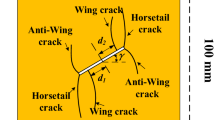Abstract
Crack damage results in a decrease of elastic wave velocities and in the development of anisotropy. Using non-interactive crack effective medium theory as a fundamental tool, we calculate dry and wet elastic properties of cracked rocks in terms of a crack density tensor, average crack aspect ratio and mean crack fabric orientation from the solid grains and fluid elastic properties. Using this same tool, we show that both the anisotropy and shear-wave splitting of elastic waves can be derived. Two simple crack distributions are considered for which the predicted anisotropy depends strongly on the saturation, reaching up to 60% in the dry case. Comparison with experimental data on two granites, a basalt and a marble, shows that the range of validity of the non-interactive effective medium theory model extends to a total crack density of approximately 0.5, considering symmetries up to orthorhombic. In the isotropic case, Kachanov's (1994) non-interactive effective medium model was used in order to invert elastic wave velocities and infer both crack density and aspect ratio evolutions. Inversions are stable and give coherent results in terms of crack density and aperture evolution. Crack density variations can be interpreted in terms of crack growth and/or changes of the crack surface contact areas as cracks are being closed or opened respectively. More importantly, the recovered evolution of aspect ratio shows an exponentially decreasing aspect ratio (and therefore aperture) with pressure, which has broader geophysical implications, in particular on fluid flow. The recovered evolution of aspect ratio is also consistent with current mechanical theories of crack closure. In the anisotropic cases—both transverse isotropic and orthorhombic symmetries were considered—anisotropy and saturation patterns were well reproduced by the modelling, and mean crack fabric orientations we recovered are consistent with in situ geophysical imaging.
Our results point out that: (1) It is possible to predict damage, anisotropy and saturation in terms of a crack density tensor and mean crack aspect ratio and orientation; (2) using well constrained wave velocity data, it is possible to extrapolate the contemporaneous evolution of crack density, anisotropy and saturation using wave velocity inversion as a tool; 3) using such an inversion tool opens the door in linking elastic properties, variations to permeability.
Similar content being viewed by others
Author information
Authors and Affiliations
Rights and permissions
About this article
Cite this article
Schubnel, A., Benson, P.M., Thompson, B.D. et al. Quantifying Damage, Saturation and Anisotropy in Cracked Rocks by Inverting Elastic Wave Velocities. Pure appl. geophys. 163, 947–973 (2006). https://doi.org/10.1007/s00024-006-0061-y
Received:
Revised:
Accepted:
Issue Date:
DOI: https://doi.org/10.1007/s00024-006-0061-y




